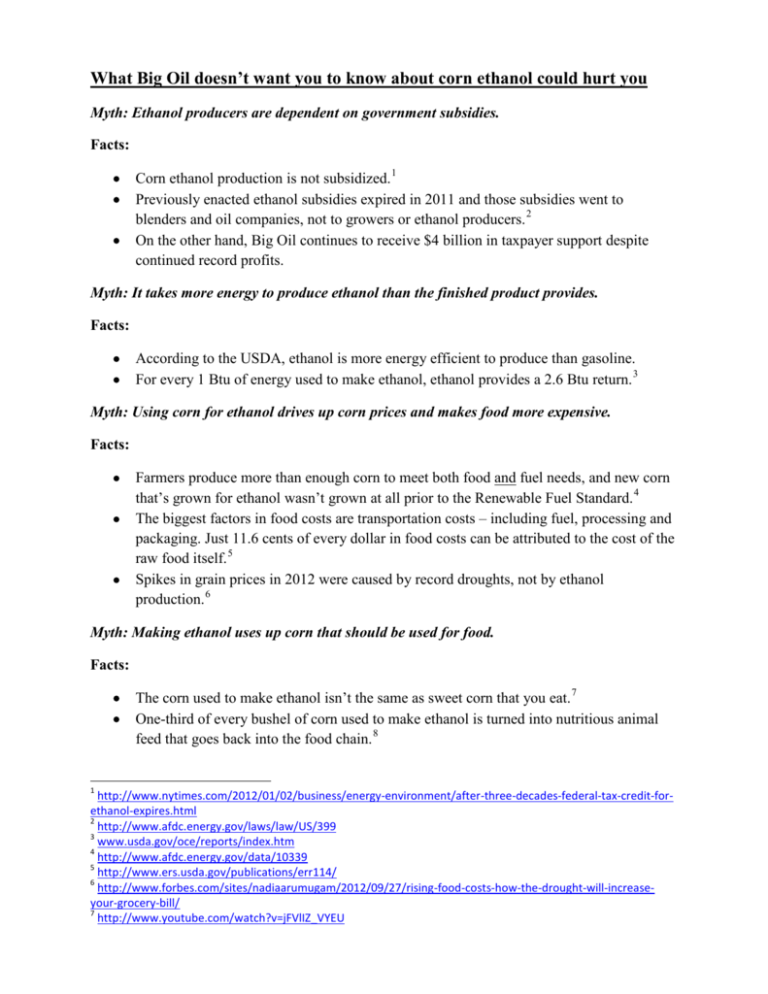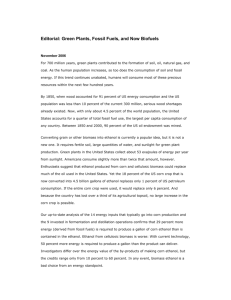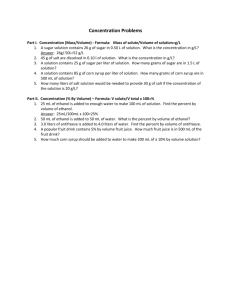What Big Oil doesn't want you to know about corn ethanol could hurt
advertisement

What Big Oil doesn’t want you to know about corn ethanol could hurt you Myth: Ethanol producers are dependent on government subsidies. Facts: • • • Corn ethanol production is not subsidized. 1 Previously enacted ethanol subsidies expired in 2011 and those subsidies went to blenders and oil companies, not to growers or ethanol producers. 2 On the other hand, Big Oil continues to receive $4 billion in taxpayer support despite continued record profits. Myth: It takes more energy to produce ethanol than the finished product provides. Facts: • • According to the USDA, ethanol is more energy efficient to produce than gasoline. For every 1 Btu of energy used to make ethanol, ethanol provides a 2.6 Btu return. 3 Myth: Using corn for ethanol drives up corn prices and makes food more expensive. Facts: • • • Farmers produce more than enough corn to meet both food and fuel needs, and new corn that’s grown for ethanol wasn’t grown at all prior to the Renewable Fuel Standard. 4 The biggest factors in food costs are transportation costs – including fuel, processing and packaging. Just 11.6 cents of every dollar in food costs can be attributed to the cost of the raw food itself. 5 Spikes in grain prices in 2012 were caused by record droughts, not by ethanol production. 6 Myth: Making ethanol uses up corn that should be used for food. Facts: • • 1 The corn used to make ethanol isn’t the same as sweet corn that you eat. 7 One-third of every bushel of corn used to make ethanol is turned into nutritious animal feed that goes back into the food chain. 8 http://www.nytimes.com/2012/01/02/business/energy-environment/after-three-decades-federal-tax-credit-forethanol-expires.html 2 http://www.afdc.energy.gov/laws/law/US/399 3 www.usda.gov/oce/reports/index.htm 4 http://www.afdc.energy.gov/data/10339 5 http://www.ers.usda.gov/publications/err114/ 6 http://www.forbes.com/sites/nadiaarumugam/2012/09/27/rising-food-costs-how-the-drought-will-increaseyour-grocery-bill/ 7 http://www.youtube.com/watch?v=jFVlIZ_VYEU Myth: Gasoline blended with ethanol will damage your car’s engine. Facts: • • • • • Ethanol is the most extensively tested fuel ever brought to market and consumers have been using blended ethanol fuels for decades. The EPA approved E15 fuel for use in all cars made since 2001. 9 This is based on more than 6 million miles of testing on 86 engines. In contrast, Big Oil and the auto companies paid for a flawed study to justify their claims that tested just 8 engines, many of which were known to have mechanical issues. 10 NASCAR has run nearly 5 million miles of races on E15 fuel. 11 Ethanol has an octane rating of 113, making it the highest performing fuel on the market. 12 Myth: Growing corn for ethanol damages the environment by causing land to be deforested and increasing use of farm chemicals. Facts: • • Thanks to modern technology, today’s corn growers are producing more corn on less land and with fewer resources per bushel than ever before. 13 According to the Fertilizer Institute, in 2010, farmers grew nearly twice as much corn using half as much fertilizer per bushel compared to 1980. 14 Myth: Ethanol doesn’t reduce CO2 emissions. Facts: • • 8 Using corn ethanol decreases greenhouse gas emissions by 34 percent compared to gasoline. 15 In 2012, the 13.2 billion gallons of ethanol produced reduced greenhouse gas emissions from on-road vehicles by 33.4 million tons. 16 http://www.ethanolrfa.org/pages/ethanol-facts-agriculture http://www.epa.gov/otaq/regs/fuels/additive/e15/e15-faq.htm 10 http://energy.gov/articles/getting-it-right-accurate-testing-and-assessments-critical-deploying-next-generationauto 11 http://green.nascar.com/biofuel-powers-nascar 12 http://www.ethanolrfa.org/pages/ethanol-facts-engine-performance 13 USDA - National Agricultural Statistics Service 14 http://www.tfi.org/statistics/fertilizer-use 15 http://iopscience.iop.org/1748-9326/7/4/045905/ 16 http://www.ethanolrfa.org/pages/ethanol-facts-environment#sthash.Yh2Spwjf.dpuf 9







